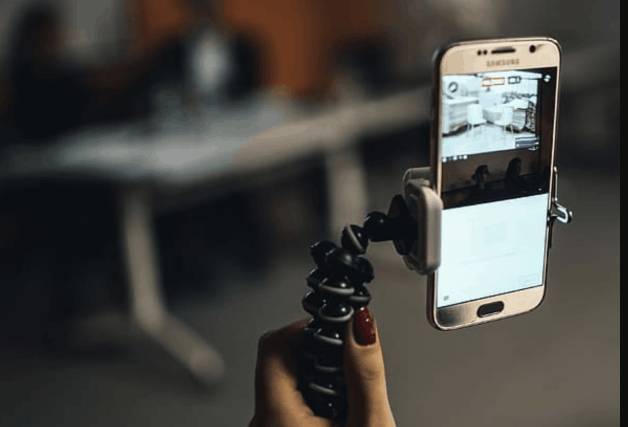I’ll confess, I’ve long dreamed of filming the next viral video. I imagine the thousands of shares, the glowing media coverage, and how I’ll then become an Instagram influencer and people will pay me to use their skincare products. Sadly, however, the latest video of my deadlifting has failed to achieve such status for me.
What you need to start filming video with your mobile phone
There are five different things to think about.
Mobile phone
If you’ve got a smartphone, you’re probably already good to go. Most smartphones these days can film high-quality video.
Sound
This is the #1 most important thing, assuming you already have a smartphone. Using your phone microphone is bad. It’s in the wrong place, it’ll record badly, and your videos will be much worse for it. Natasha corroborated other recommendations I’ve come across in suggesting the Rode smartLav, instead.
Once you’ve got the smartLav (or equivalent), it’s strongly recommended to record video and audio with the same phone: avoid creating a separate audio file that you’ll then have to sync up. For interviews, it turns out this is super easy. You can also get an extension cable for the smartLav if you need to film from a longer distance.
Grips
This is a fancy industry term for a thingy you use to hold your phone. Start throwing it around in conversations with video contractors and they’ll knock 50% off their quote once they realise how savvy you are. A grip isn’t essential, but it can help to reduce shakiness and potentially free up your hands. Some types of grips you can consider are:
A tripod,
A selfie stick with a tripod,
A gorilla grip (such as this one), can give you more flexibility and can be easier to mount on things, &/or
A gimbal (aka vimbal/vimble) – this is the fancy thing that you hold and it’s like a gyroscope or something that keeps the phone steady even as you move around. Great for tracking shots. Apparently these are much cheaper than they used to be (nowadays about $150).
Lighting
You don’t need fancy lighting. Ideally you can use daylight or indoor lighting if you need. The important thing is that the light is falling towards the subject. Avoid a situation where the subject is between the camera and a light source. If need be, you can also use the flashlight of a second smartphone to provide some soft lighting.
Storage and batteries
Think ahead – make sure you won’t run out of space or juice. Standard filming uses about 150mb/minute, so make sure to have enough space and maybe delete some junk from your phone beforehand. Avoid filming in 4k, as it’s not really worth the additional space consumption.
For battery, make sure to start with a good charge, but you probably also want to get yourself a battery pack or similar so that you can keep charging while you are out and about.
Tips for shooting interviews
Next up we got a bunch of tips for shooting, especially interviews. At first, I thought this was oddly specific, but the idea is that even if your final video doesn’t look like an interview, you use interviews to get the soundbites that you use in the video. Probably the end result won’t show the interviewer or the questions, but the responses stand alone and are used to craft the narrative of the video.
So here’s how to do it.
Shooting
Generally, you want to shoot horizontally, ie landscape. If you are very sure that the video is for a vertical format (like an Instagram story) that’s maybe different, but it’s a lot easier to go from landscape to portrait than vice-versa.
Don’t use the digital zoom! It makes everything look pixelated. Just get, in the timeless words of The Cure, close to me.
Give your phone lens a quick wipe before you start.
Interviewing
Apply the “rule of thirds”. That is, frame your shot so that the subject is in the left or right vertical third of the shot. They should be angled towards the centre such that an imaginary speech bubble out of their mouth would fill up the rest of the frame.
Height: the camera lens, the subject’s eyes, and the interviewer’s eyes should all be at the same level. Sitting down can help with this.
Use the background to tell a story. Think strategically about what’s going to be in the shot besides the subject.
Headroom: allow a bit of space above the head of the subject, as if they were wearing a small tiara.
Make sure that the subject answers questions with full sentences so that it will make sense once you edit out the questions!
Cutaways and B-Roll
Your video won’t be just talking heads though. “Cutaways” aka “B-Roll” are other shots you get for variety and visual interest. For example, every time there is a news story about power prices they have endless shots of people flicking on air conditioners. Hopefully though yours will be less cliched.
Here the tips are:
Get about five seconds of each shot.
Use cutaways to convey the story you are telling: people in action, still or moving objects, scenery. Think about what imagery will help tell the story.
Use shots at a variety of distances: wide shots to give a sense of place, medium shots to cover who and what, tight shots to give detail.
Think about the camera angle and maybe play with it: you might film upwards, downwards, over the shoulder…different angles will convey a different meaning.
If you are moving your phone while filming, use subtle and controlled movements. Move very slowly. Otherwise, the footage will end up feeling very fast.
Editing
Almost there! You’ve got your A-roll (the interview content!), you’ve got your B-roll (the cutaways). Now you’re ready to put it all together.
As described by Natasha, the five steps of editing are:
1. File organisation
Get everything in the one place, even if it just means favouriting things on your smartphone or moving them all into a new folder. This will make your life a lot easier!
2. Create soundbites
Go through your A-roll and get rid of interviewer questions, ending up just with the responses. Then find the responses that you want to use to tell your story, and get them into the right order. You’re beginning to shape your narrative.
3. Cutaways
Think about what’s being said in each soundbite, and what cutaways will work with the content? In particular, when you jump from one soundbite to another, it will look disjointed – you can use a cutaway to paper over the transitions so that it’s smoother. (Imagine: Footage of soundbite 1 > cutaway 1 > Footage of soundbite 2 )
4. Titles and transitions
Gotta have ‘em.
5. Exporting
Gotta do it.
Your software options are:
Kinemaster comes highly recommended for Android or iPhone. The user interface looked very friendly. There is a free version (with watermark) or it is $7.50 per month.
Other options for mobile are splice (iPhone) or quik (Android / iPhone).
On a laptop, Filmora comes highly recommended. You can try it for free and then buy a lifetime license. Another fancy option to check out is Lumen5: it’s like Canva for video! That is, it sort of automatically can turn a story into an interesting video.
That’s a wrap
After Natasha’s workshop, I was kicking myself for the mistakes I’d previously made when making video, and also for all the times I didn’t make a video because I didn’t know how to do it. To be fair, creating a good story isn’t simple. But it’s a lot easier when you know a bit about the craft. So good luck with your storytelling, and I hope you end up with many unsolicited skincare products.








